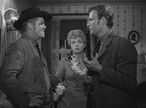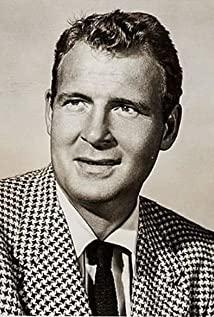Although less important than the gun, another important element of the Western, the woman immediately appears in the next shot of Winchester 73. When a stagecoach was parked on the street, Lin saw a middle-aged man forcibly chasing a beautiful woman up, so he stepped forward as a hero to save Mei. But the result was unexpected, the woman smiled and praised the handsome man but got into the car obediently. Then the middle-aged man asked them to hand over their pistols. Lin was puzzled. The middle-aged man pulled out a police badge in his pocket and said he was Sheriff White. So Lin put down his hand that wanted to draw the gun, and handed the gun to the other party for safekeeping. From suspicion to conviction, not because of the sheriff, nor because of Dodgetown's rules, but because of the name: Wyatt Earp, one of the most widely known legends in Western mythology.
"Winchester 73" was released in 1950, which was the heyday of Westerns and the most perfect stage of the classic model of Westerns. There's no fight, no gunfight, or even suspense in these opening episodes, but for a Western fan, everything is exciting: remote but bustling town, passers-by, unknown quest, best guns , the most beautiful woman, the most legendary sheriff... but the following plot slowly deviates from expectations. After a shooting competition where everyone can show their abilities, Lin won the one-in-a-million Winchester renju with his unrivaled marksmanship, but was immediately replaced by Holland, played by Stephen McNally. Man Brown snatched. So Lin and his companions left the town and began a long search.
As a result, the story has shifted from the gregarious town to the wilderness. The legendary Sheriff White remains in the well-ordered and civilized world, while Lin, with his unknown hatred and hatred for guns, embarks on a simple journey. But a dangerous journey. It is difficult to say that this is the inheritance or subversion of tradition. Anthony Mann is not entangled in the opposition between order and lawlessness, nor does he care about the conflict between individuals and groups. For him, the best Western mythology may be one man and one horse. Endless pursuit in the vast grassland or desert. Good and evil humanity, civilization and savagery, law and justice, and everything else in the Western film, is materialized in this story and projected onto the greatest symbol of desire, the Winchester lance. Compared with this objectified gun, it is not so much that Lin leads us through a western myth, but that the gun leads us into a western world, explaining how various western myths are repeated on this land.
Through the circulation of guns between different characters, all kinds of western characters appear in the plot one by one: sharpshooters, robbers, gamblers, arms dealers, Indian tribes, ill-fated women, etc... In these characters and the life and death of intrigue Between the battles, Anthony Mann shows us a brutal and realistic true West. Here, the battle between people is no longer limited to the battle between good and evil. Behind the hero's act of revenge, there is actually a bitter ethical tragedy; and the death attack of the Indians is not just a confrontation between the barbarian and civilization, but the unremitting pursuit of the right to live; the experience of guns and women proves that There is not only no morality, but also no morality between people, and some are just crazy possessiveness. Behind these appearances, Anthony Mann quietly began to deconstruct the myth, thus pointing directly to the brutal law of the jungle in American society.
Martin Scorsese once said Winchester 73 was a tough western, but the truth is a little different. As far as the protagonist Lin McAdam played by James Stewart is concerned, although he has the marksmanship of a hundred paces through Yang, he is not the kind of powerful man. Compared with the traditional heroes in Western films, he is a little mild or even weak. . Shortly after the story begins, he is hand-picked by the Dutch and his accomplices, an ambush, a detail rarely seen in the protagonist of a Western. What can best reflect his character is the impression of him by the Dutch Henry Brown. We know from the last episode that he is actually Lin's brother. The two met for the first time at the Dodge House because of the presence of White Earp so there was no fight, but the Dutchman ordered a glass of goat's milk instead of cow's milk for his brother, which speaks volumes about his contempt for his brother and his vengeance . Lynn McAdam's perseverance in his search obviously also contains a sense of self-baptism, as evidenced by his companion's lack of participation in the duel between the two brothers from beginning to end.
From this point of view, part of the strong impression on Martin Scorsese's memory may be due to the ruthlessness of the law of the jungle, the strong contrast between the protagonist and the villain; another part should come from "Winchester" 73, the use of wide-angle lenses and deep focal lengths, a style Martin Scorsese credits with Orson Welles (Citizen Kane). In Winchester 73, this technique brings more depth to the story. When the characters are in the natural environment, the insignificance of the characters and the vastness of the space form a strong and exaggerated contrast, which is an important feature of the visual map of Western films; when the scene is in a block with many characters, the use and composition of this lens emphasizes The internal scheduling gives the story a strong sense of realism; when the scene is located in a closed space, this usage enriches the information of the picture, and also strengthens the conflict and opposition between the characters. However, compared with Wells's more long shots, Anthony Mann's shot editing is obviously more frequent, and the classic coherent editing and dialogue editing also bring a certain hard-key feeling.
Compared with this vague and unobvious feeling, the calm temperament in "Winchester 73" is obviously more prominent. This is due to the fact that Anthony Mann rarely moves the camera, and relies more on internal scheduling to effectively grasp the progress and rhythm of the plot in the story. Corresponding to this style, the story reduces the performance of action scenes such as character gunfights and chases, but enhances the performance of the inner activities and conflicts of the characters, which distances itself from the classic western films. In action scenes, Anthony Mann emphasizes the creation of atmosphere, and is good at using the contrast between movement and stillness to highlight tense situations. This is especially evident in a scene where the crowd gathers in the valley against the Indians. After the chase and confrontation, the plot turned to a rest in the night; when the battle was about to start the next morning, and everyone was waiting nervously, Anthony Mann did not give any information to the other party, but suddenly inserted two empty shots, which were effective. Extending the screen time and delaying the climax, at the end of the second shot, the camera pan is aimed at the Indian warriors who are ready to go. In this section, instead of the usual cross-cutting, Anthony Mann enhances the climax by contrasting stillness and movement.
Winchester 73 is also extremely well-structured. The story contains two main lines, the dark line is the revenge that runs through the whole film, and the bright line is the tossing and turning of the gun. The latter occupies the main position in the story, and at the same time combines the auxiliary line of the fate of the woman. At the end of the second act of the story, these threads are completely intertwined, resulting in the greatest triune scene that a play seeks. The third act is a thrilling confrontation. The ending solves all the problems of the story. Lin Chenggong's revenge retrieves the lost Winchester 73, captures the hearts of beautiful women, and even possible rivals in love are there Disappears in the second act, escaping the moral dilemma that might be faced. Note that these two clues have their own forms. The main line of revenge is a linear development, which determines the start and end time of the story; the clue of the gun's turning is a symmetrical arc structure, which was first obtained by Lin, and then turned between different characters. In between, the middle intersects with another main line, and finally returns to his hand. For a Western, it's unquestionably perfect.
View more about Winchester '73 reviews











